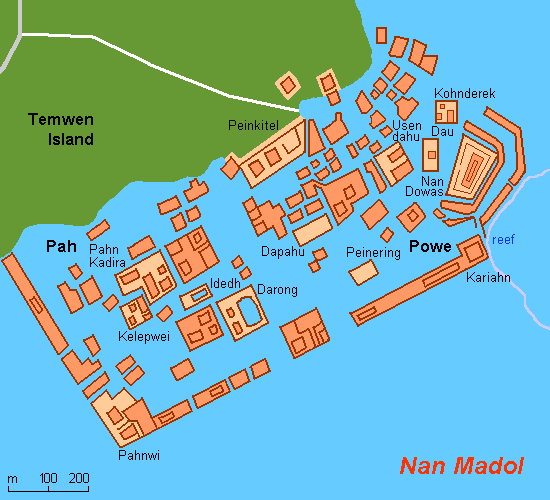A Brief History Of Mu/Lemuria: Between Fact And Fiction
Stories about ancient lost continents have been fascinating and amazing throughout the passage of time. The stories or myths about the rise and fall of ancient lost civilisations which, according to legend, inhabited these submerged vast continents have fascinated mankind for a long time. Many of these stories have a common aspect regarding the downfall of these legendary sunken continents, more specifically a great deluge. This article will briefly examine the story of such a legendary continent, namely Lemuria.
But, first of all, a noteworthy question: Mu or Lemuria?
In other words, is Lemuria Mu or Mu Lemuria? Is either of those two names the same denoting the other? Long story short, not quite. But the actual answer is a little bit more complex than that. Sometimes, they are distinct terms referring to distinct continents, other times they can refer to the very same continent. Given the fact that the story behind the legendary lost sunken continent of Lemuria largely emerged back in the 19th century, primarily through the works of James Churchward, there has been a bit of controversy regarding whether these two terms are interchangeable. Regarding the rise and downfall of this legendary ancient civilisation, other authors such as Helena Blavatsky and Rudolf Steiner proposed various theories on its nature, evolution, and eventual demise or vanishment. Theosophy, a form of mysticism, has related stories on the rise and fall of the ancient legendary continent of Lemuria. Additionally, Lemuria is alternatively placed in the Indian Ocean and sometimes referred to as Kumari Kandam in Tamil literature. Below you can watch a very interesting and well documented video on YouTube by the channel Universe Inside You on the theory according to which Lemuria was situated in the Indian Ocean:
Lemuria and the Pacific Ocean
Concerning the geographic location of the legendary continent of Lemuria, according to legend, it existed across the Pacific Ocean many thousand years ago. After it submerged behind its waves, this legendary continent is believed to have left several traces behind. These ‘traces’ are represented by a series of islands situated across the vast Pacific Ocean. Some of them are Fiji, Hawaii, or Easter Island. According to legend, the ancient continent of Lemuria (as per the writings of James Churchward, a British colonel, author, and inventor, born in 1951 and deceased in 1936), was the cradle of civilisation and the motherland of mankind. Furthermore, the ancient lost legendary continent of Lemuria (or Mu) was inhabited by the so-called Naacals. James Churchward published a series of books based on his research on the lost legendary continent of Lemuria. Those books are the following ones (all of them published during the interwar period):
- The Lost Continent of Mu, the Motherland of Men (published in 1926)
- The Children of Mu (published in 1931)
- The Sacred Symbols of Mu (published in 1933)
- Cosmic Forces of Mu (published in 1934)
- Second Book of Cosmic Forces of Mu (published in 1935)

Map depicting the geographic location of the legendary lost continent of Mu/Lemuria across the Pacific Ocean, stretching over an impressive landmass from Ladrones to Easter Island. The map was made by British colonel, inventor, and author James Churchward and taken from one of his books, namely The Lost Continent of Mu which was published in 1926. Image source: Wikimedia Commons (author: James Churchward, under CC0 licence, therefore available in the public domain)
While James Churchward’s works are considered pseudoscience and hoax-like by the scientific community, it should be mentioned that throughout the passage of time scientists reviewed concepts about subjects considered as such in the past and that, relatively recently, new submerged continents were discovered (such as, most notably, Zeelandia, which, coincidentally or not, is situated in the southern Pacific Ocean, west respectively southwest of Australia, with the islands of New Zealand as its principal remains). 94% of the former territory of Zeelandia is submerged, the rest still on surface being represented by New Caledonia and New Zealand. Back to Lemuria/Mu, it is believed that it was a highly advanced and spiritual civilisation, with its inhabitants living in peace and harmony with nature.
In terms of popular culture, one of the books written by James Churchward influenced the British classic rock band Led Zeppelin in terms of symbolism, with lead vocalist and frontman Robert Plant claiming he took the symbol representing him (i.e. the feathered circle) which can be seen on the inner sleeve and record label of the famous Led Zeppelin IV studio album (released in 1971) from The Sacred Symbols of Mu (1933). At the same time, this ancient occult symbol also represents Ma’at, the ancient Egyptian concept and goddess of truth, justice, and order. Furthermore, according to the writings of colonel James Churchward, the civilisation of ancient Egypt was influenced by the lost legendary continent of Mu (Lemuria). At the same time, according to American medium Edgar Cayce, ancient Egypt was also influenced by Atlantis, another legendary submerged lost continent thought to be situated in the North Atlantic Ocean. And here the story gets quite interesting if pieced together in my humble opinion. Could it be that ancient Egypt, if the legends are true according to both Edgar Cayce and James Churchward, was influenced by both Atlantis and Lemuria? That remains to be seen… Last but not least, in this particular regard (more with respect to the influence Atlantis exerted on ancient Egypt), it is believed that there is a certain Hall of Records beneath the Sphinx in Egypt, a sacred room full of ancient knowledge on the lost continent of Atlantis (possibly also Lemuria, who knows?).
Two noteworthy remnants of this legendary continent of Lemuria/Mu are believed to be the Yonaguni submerged rock monument (situated in the northern Pacific Ocean, part of Japan and close to Taiwan) as well as the ruined city of Nan Madol on the island of Pohnpei (which, coincidentally, sounds strikingly similar to Pompei) which is also a UNESCO-recognised World Heritage Site and the Ceremonial Centre of Eastern Micronesia (in the western Pacific Ocean).

Map depicting the geographical position of the legendary lost continent of Mu/Lemuria in the Pacific Ocean, taken from Books of the Golden Age by British colonel, inventor, and author James Churchward, published in 1927. Image source: Wikimedia Commons (author: James Churchward, under CC0 licence, therefore available in the public domain)

The submerged Yonaguni rock monument in the northern Pacific Ocean, part of Japan and close to Taiwan. Image source: Wikimedia Commons (author: Wikimedia Commons user Melkov, under CC0 licence, therefore available in the public domain)

The ruins of Nan Madol, adjacent to Pohnpei Island, Federated States of Micronesia, western Pacific Ocean. Image source: Wikimedia Commons (author: NOAA, under CC0 licence, therefore available in the public domain)

Map of Nan Madol near the island of Temwen, Federated States of Micronesia, western Pacific Ocean. Image source: Wikimedia Commons (author: Wikimedia Commons user Quarot, under CC0 licence, therefore available in the public domain)
In the end…
In the end, whether the lost legendary continent of Lemuria existed or not is still a matter of debate and only time can tell whether it actually existed, as in the case of the famed legendary continent of Atlantis. According to legend, it is even said that the downfall of both Atlantis and Lemuria came after these two legendary civilisations clashed in a devastating war. However, only time can clarify these aspects in the future, based on also on additional scientific discoveries. What is known for certain is that relatively few things are known for certain regarding the vastness of the oceans’ beds (and what lies there)… which speaks volume of their mysteries.
Otherwise, as in the case of the demise of Atlantis, it is believed that the survivors of the catastrophes which shattered Lemuria/Mu went on to form the basis of the first known or recorded civilisations in mankind’s history (i.e. ancient Egypt, ancient India, the ancient Mesoamericans, etc.), being nonetheless just shadows of the former glory of humanity’s motherland and therefore a far cry in terms of technology and spirituality.
P.S. On a personal note, even if the entire story behind the legendary story of Lemuria/Mu (as it is also the case of Atlantis) is just pure fiction or mythology, it definitely is quite entertaining fiction!
Documentation sources and external links:
- Mu (mythical lost continent) on www.wikipedia.org (in English)
- Lemuria on www.wikipedia.org (in English)
- Lemuria and Mu on www.encyclopedia.com
- Lost Continents of Mu and Lemuria on www.historicmysteries.com (article by Shelly Barclay)
- Deities in Ancient Egypt – Ma’at on www.egyptianmuseum.org
- Led Zeppelin’s four symbols on www.loudersound.com

